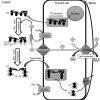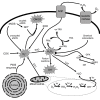8-oxo-7,8-dihydro-2'-deoxyguanosine (8-oxodG) and 8-hydroxy-2'-deoxyguanosine (8-OHdG) as a Cause of Autoimmune Thyroid Diseases (AITD) During Pregnancy?
- PMID: 33005115
- PMCID: PMC7513436
8-oxo-7,8-dihydro-2'-deoxyguanosine (8-oxodG) and 8-hydroxy-2'-deoxyguanosine (8-OHdG) as a Cause of Autoimmune Thyroid Diseases (AITD) During Pregnancy?
Abstract
The thyroid is not necessary to sustain life. However, thyroid hormones (TH) strongly affect the human body. Functioning of the thyroid gland affects the reproductive capabilities of women and men, as well as fertilization and maintaining a pregnancy. For the synthesis of TH, hydrogen peroxide (H2O2) is necessary. From the chemical point of view, TH is a reactive oxygen species (ROS) and serves as an oxidative stress (OS) promoter. H2O2 concentration in the thyroid gland is much higher than in other tissues. Therefore, the thyroid is highly exposed to OS. 8-oxo-7,8-dihydro-2'-deoxyguanosine (8-oxodG) and 8-hydroxy-2'-deoxyguanosine (8-OHdG) are DNA lesions resulting from ROS action onto guanine moiety. Due to their abundance, they are recognized as biomarkers of OS. As thyroid function is correlated with the level of OS, 8-oxodG and 8-OHdG has been taken under consideration. Studies correlate the oxidative DNA damage with various thyroid diseases (TD) such as Hashimoto's thyroiditis (HT), Graves' disease (GD), and thyroid cancer. Human sexual function and fertility are also affected by OS and TD. Hypothyroidism and hyperthyroidism diagnosed in pregnant women have a negative effect on pregnancy as it may increase the risk of miscarriage or fetus mortality. In the case of TD in the mother, fetal health is also at risk - neurodevelopment and cognitive function of the child may be impaired in its future life. This review presents thyroid function in the context of TD during pregnancy. The authors introduce OS and describe oxidative DNA lesions as a crucial marker of thyroid pathologies.
Keywords: DNA damage; deoxyguanosine; oxidative stress; pregnancy; thyroid diseases; thyroid hormones.
Copyright ©2020, Yale Journal of Biology and Medicine.
Figures




Similar articles
-
Hepatitis B Virus X Protein Increases 8-Oxo-7,8-Dihydro-2'-Deoxyguanosine (8-Oxodg) Level via Repressing MTH1/ MTH2 Expression in Hepatocytes.Cell Physiol Biochem. 2018;51(1):80-96. doi: 10.1159/000495166. Epub 2018 Nov 16. Cell Physiol Biochem. 2018. PMID: 30448843
-
8-Oxo-7,8-Dihydro-2'-Deoxyguanosine (8-oxodG) and 8-Hydroxy-2'-Deoxyguanosine (8-OHdG) as a Potential Biomarker for Gestational Diabetes Mellitus (GDM) Development.Molecules. 2020 Jan 3;25(1):202. doi: 10.3390/molecules25010202. Molecules. 2020. PMID: 31947819 Free PMC article. Review.
-
8-Oxo-7,8-dihydro-2'-deoxyguanosine, reactive oxygen species and ambulatory blood pressure in African and Caucasian men: the SABPA study.Free Radic Res. 2014 Nov;48(11):1291-9. doi: 10.3109/10715762.2014.951840. Epub 2014 Sep 2. Free Radic Res. 2014. PMID: 25096646
-
Oxidative DNA damage and cellular sensitivity to oxidative stress in human autoimmune diseases.Ann Rheum Dis. 1993 Sep;52(9):659-66. doi: 10.1136/ard.52.9.659. Ann Rheum Dis. 1993. PMID: 8239761 Free PMC article.
-
8-oxoguanine and 8-oxodeoxyguanosine Biomarkers of Oxidative DNA Damage: A Review on HPLC-ECD Determination.Molecules. 2022 Mar 1;27(5):1620. doi: 10.3390/molecules27051620. Molecules. 2022. PMID: 35268721 Free PMC article. Review.
Cited by
-
Vitamin B12-Multifaceted In Vivo Functions and In Vitro Applications.Nutrients. 2023 Jun 13;15(12):2734. doi: 10.3390/nu15122734. Nutrients. 2023. PMID: 37375638 Free PMC article. Review.
-
Lactoferrin alleviates oxidative stress and endoplasmic reticulum stress induced by autoimmune thyroiditis by modulating the mTOR pathway in the thyroid.J Endocrinol Invest. 2025 Apr;48(4):861-876. doi: 10.1007/s40618-024-02505-0. Epub 2024 Nov 22. J Endocrinol Invest. 2025. PMID: 39576556
-
Icariside II protects dopaminergic neurons from 1‑methyl‑4‑phenylpyridinium‑induced neurotoxicity by downregulating HDAC2 to restore mitochondrial function.Exp Ther Med. 2023 Nov 28;27(1):40. doi: 10.3892/etm.2023.12328. eCollection 2024 Jan. Exp Ther Med. 2023. PMID: 38125349 Free PMC article.
-
Pregnancy-associated thyroid disorders: the role of genetic, epigenetic, and oxidative stress factors.Rev Endocr Metab Disord. 2025 Aug;26(4):679-692. doi: 10.1007/s11154-025-09974-5. Epub 2025 Jun 9. Rev Endocr Metab Disord. 2025. PMID: 40484893 Free PMC article. Review.
References
-
- WHO Assessment of the iodine deficiency disorders and monitoring their elimination. Geneva: WHO; 2007. pp. 1–107.
Publication types
MeSH terms
Substances
LinkOut - more resources
Full Text Sources
Medical
Research Materials
